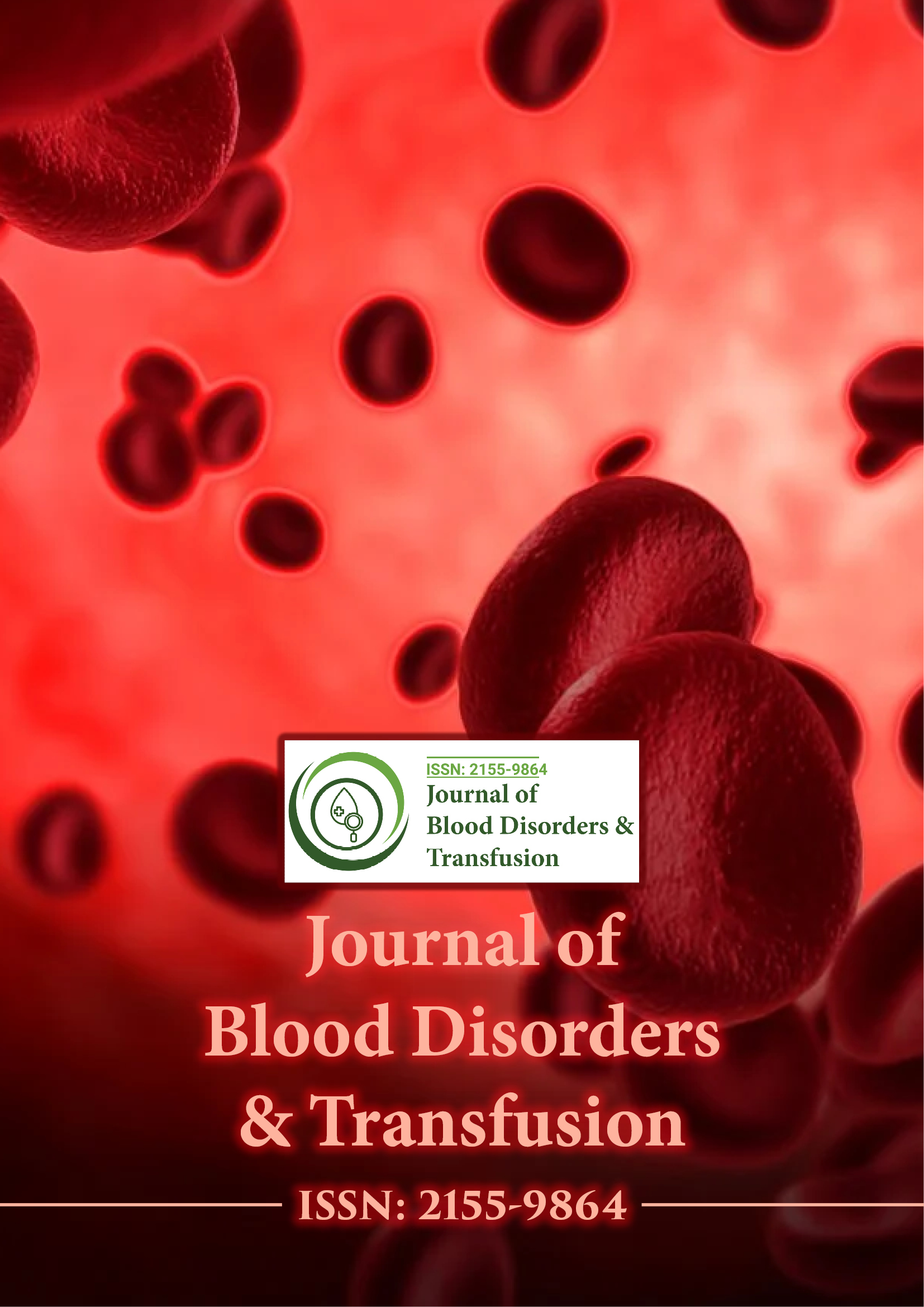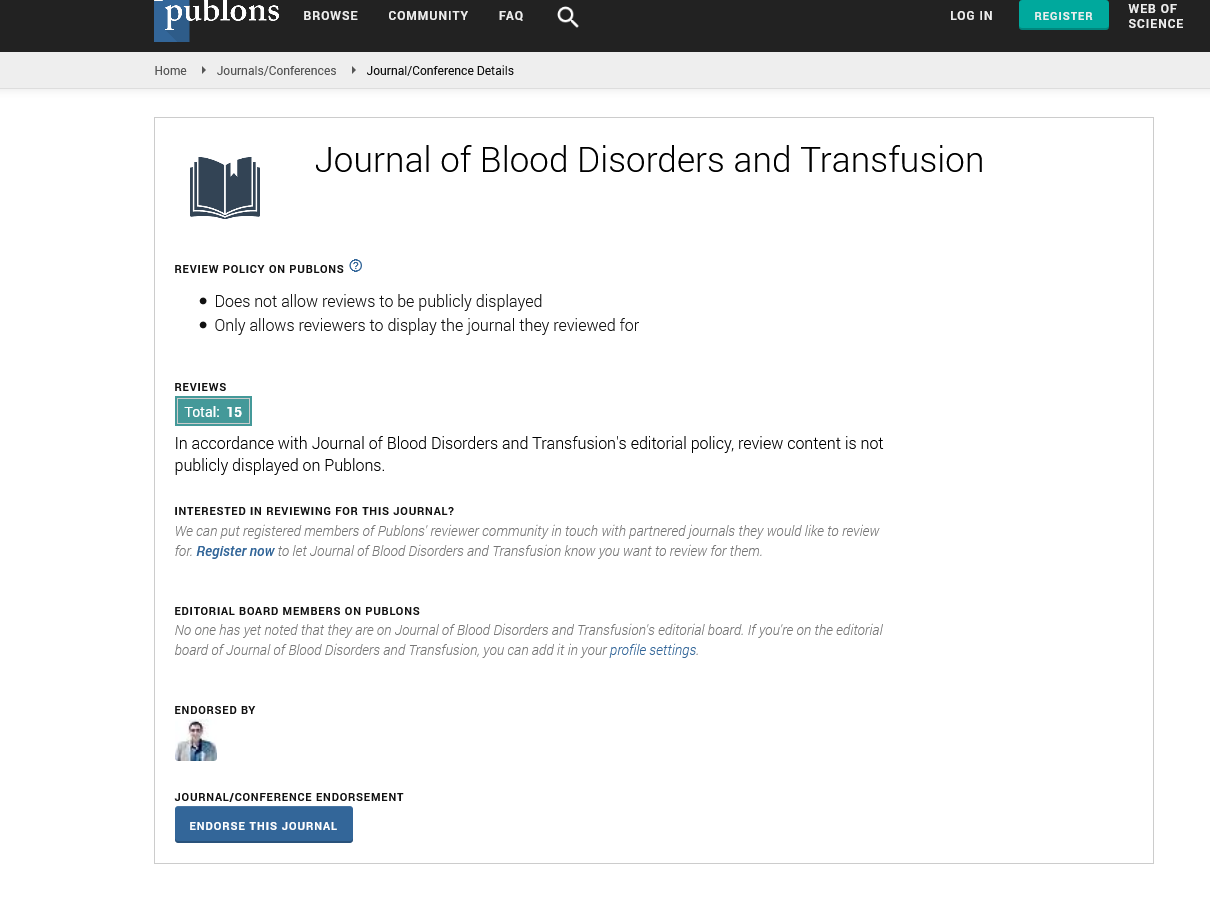Indexed In
- Open J Gate
- Genamics JournalSeek
- JournalTOCs
- Ulrich's Periodicals Directory
- RefSeek
- Hamdard University
- EBSCO A-Z
- OCLC- WorldCat
- Proquest Summons
- Publons
- Geneva Foundation for Medical Education and Research
- Euro Pub
- Google Scholar
Useful Links
Share This Page
Journal Flyer

Open Access Journals
- Agri and Aquaculture
- Biochemistry
- Bioinformatics & Systems Biology
- Business & Management
- Chemistry
- Clinical Sciences
- Engineering
- Food & Nutrition
- General Science
- Genetics & Molecular Biology
- Immunology & Microbiology
- Medical Sciences
- Neuroscience & Psychology
- Nursing & Health Care
- Pharmaceutical Sciences
Short Communication - (2025) Volume 16, Issue 1
Radiographic Evaluation of Blood and Pulmonary Embolus Study at Mouwasat University Hospital on the Radiological Signs of Pulmonary Embolus on Plain Chest Images and CT Scans
Khalid Khattab* and Yara AldahoukReceived: 30-Oct-2023, Manuscript No. JBDT-23-23648; Editor assigned: 02-Nov-2023, Pre QC No. JBDT-23-23648 (PQ); Reviewed: 16-Nov-2023, QC No. JBDT-23-23648; Revised: 06-Jan-2025, Manuscript No. JBDT-23-23648 (R); Published: 13-Jan-2025, DOI: 10.4172/2155-9864.25.16.611
Abstract
Pulmonary embolism results from an emboli in any part of the pulmonary circulation, it is usually caused by avenous thrombosis in the deep veins, risk factors for pulmonary embolism include three basic forms called Virchow triad: Vascular trauma, increased coagulability, reduced blood flow, blood cancer, the clinical manifestations of pulmonary embolism are nonspecific, but their presence with one of the risk factors leads to pulmonary embolism, and then we carry out appropriate investigations and measures, plain chest X-ray is often non directional and is used to ruleout symptoms clinically similar to pulmonary embolus, pulmonary angiography is currently considered the gold standard for diagnosis, It is often performed using the multishider technique, wich has asensitivity and specificity equal to contrast angiography, but it is a non-invasive procedure and is therefore more widely used.
Keywords
Pulmonary embolus; Blood; Heme computed tomography; Cancer; Plain scan; Mowasat University Hospital; Radiological signs
Introduction
A pulmonary embolus is an embolus placed in the pulmonary trunk, the right or left pulmonary artery, or one of their branches. It often results from venous thrombosis that occurs in the deep veins, especially the veins of the lower extremities in the calf, thigh, and pelvis. This thrombus separates to form an embolus that travels through the veins to the right part of the lung. The heart and from there to the pulmonary trunk and the pulmonary arteries and their branches [1].
The rate of clot separation and causing an embolism increases as we move upward, and the highest rate is in the pelvic veins [2].
In rare cases, the source of a pulmonary embolus may be:
- Thrombosis that occurs in the right ventricle after myocardial infarction or endocarditis.
- Lipid embolism occurs due to fats reaching the blood cancer and blood from the bone marrow, especially in fractures of long bones or during orthopedic surgery.
- Fat embolus, which may form if the catheter in one of the central veins opens into the air or during diving underwater.
- Amniotic emboli as a postpartum complication.
- Tumor emboli, which consist of tumor cells.
- Air embolism due to the introduction of a foreign substance into the bloodstream and usually occurs by injecting substances into a vein, such as drug users.
- In rare cases, pulmonary embolism may occur due to the cement material entering the bloodstream after a procedure called vertebroplasty in which medical bone cement is used.
Materials and Methods
Aims of studying
Pulmonary embolism is considered an important pathological complication in all countries of the world that can lead to death in large proportions, as its diagnosis is concerned specifically with pulmonary vascular heme computed tomography, and the research aims to study the role of cancer radiological, laboratory and clinical diagnostic methods in detecting pulmonary embolism in order to carry out the appropriate and optimal procedures [3].
Study design
A cross-sectional study to study the cancer radiological investigations to diagnose pulmonary embolism, their accuracy and type, and study the most important cancer radiological signs [4].
Patients
The study included 100 male and female patients who were admitted to Al-Mouwasat University Hospital and they had a pulmonary embolism [5].
Place of study
Al-Mouwasat University Hospital-archives and records of patients in the internal department, clinics, and radiology department [6].
Study time
From March 2023 until August 2023.
Methods
A group of patients who were admitted to Al-Mouwasat University Hospital were studied according to the following inclusion criteria.
- Diagnosed cases of pulmonary embolism were monitored in the radiology department and the internal thoracic department, and the cases were followed up and managed in the hospital’s thoracic surgery department.
- Accept patients with symptoms and signs suggesting a diagnosis of pulmonary embolus.
While the exclusion criteria were as follows:
- Patients who continued treatment outside the hospital.
- Patients who had X-ray and CT outside the hospital.
- Patients who do not have a desire for diagnosis and treatment.
- Damaged patient records and records in which there is insufficient information to serve our study.
Information was collected according to the research form to adjust the inclusion and exclusion criteria. Clinical history information was recorded in detail, which included: Age, sex, habits, vital signs, and medical examinations. Information was taken about the results of the CT scan and the plain radiograph. All patient measurements were made using devices available in the hospital, and X-rays were taken at the center located in the hospital.
Results and Discussion
The study was conducted on 100 pulmonary embolism patients who were monitored at Al-Mowasat University Hospital, by referring to medical records and the Decks radiograph archiving system in the hospital during the time period extending from March to August 2023. The selected sample included 65% males, 35% females, and most the cases were within the city of Damascus, and the reason is that the cases were emergency cases, accompanying clinical symptoms: Tachypnea 92% abscess 58%, tachycardia 44% fever (temperature more than 37.8) 43%, edema of the lower extremities 21% lower venous thrombosis 32%, the importance of the Westermarck sigh relationship: Most patients had simple x-rays taken. The most important relationship was the Westermarck relationship, as this relationship is observed in the height of the diaphragm with a lung area in which no blood cancer and blood vessels are seen. The Westermarck relationship had sensitivity of 11% and specificity of 92%, laboratory tests in infected people: High blood cell count 65% D-dimer 80% and internationally in reference 95% high fibrinogen 65% and globally in reference 90% high protein C 72%, high protein S 72%, the chest X-ray was negative (normal) in a large percentage of more than 75%, so simple images have no value in evaluating and diagnosing pulmonary embolism, factors that predispose to pulmonary embolism are: Cardiac lesions 60% oral contraceptives 3% ventricular cerebral dispersion 2% trauma 10% obesity 3% concomitant infections 13% shock 5% hematological lesions 50%, measuring the embolus density according to the Hounsfield unit scale using axial heme computed tomography: A multi-slice heme computed tomography scan was performed using rapid intravenous injection of contrast material, and the diagnosis of the embolus was based on a hypo filling structure within the lumen of the artery. Embolus density according to the Hounsfield unit scale: In acute embolism (30–40). In chronic embolism (50%–60%), rates showing an embolus in the pulmonary circulation: The presence of an embolus was documented and its location determined, and the percentages were as follows: The percentage showing an embolus in the pulmonary arterial trunk was 40%, the percentage showing an embolus in the right main pulmonary artery was 23%, the percentage showing an embolus in the left main pulmonary artery was 22%. The percentage of emboli in both the right and left pulmonary arteries is 10%, and the percentage of small emboli in the arterial branches is 5%, chest radiographic findings accompanying the embolus: 3% of cases of embolism are associated with pulmonary infarction. The embolus is accompanied by other chest radiographic findings, which are: bilateral pleural effusions 80% genetic effusion small quantity 20%.
Conclusions
- Do not neglect any case in which we suspect the presence of a pulmonary embolus, because early detection leads us to quickly implement treatment, reduce complications resulting from the embolism, and reduce deaths.
- The gold standard examination of the embolus is CT with auto-injector injection.
- Follow-up of diagnosed cases until the embolus dissolves.
- There are many cases in Al-Mouwasat Hospital that have not been diagnosed due to the malfunction of the automatic injector.
- The radiology reading must be done by a radiology supervisor to achieve accuracy.
Ethical Approval and Consent to Participate
The Research Ethics Committee at Al-Sham Private University and the Ethical Committees at Al-Mowasat University Hospital approved the study protocol. All procedures performed in studies involving human participants were in accordance with the ethical standards of the institutional and/or national research committee and with the 1964 Helsinki declaration and its later amendments or ethical standards similar.
Ethical Consideration
Ethical approval was obtained from the Institutional Review Board (IRB) of the Faculty of Medicine, Al-Sham Private University, and Al-Mowasat University Hospital in Damascus.
Consent for Publication
Not applicable.
Availability of Data and Materials
All data related to this paper’s conclusion are available and stored by the authors. All data are available from the corresponding author on a reasonable request.
Conflict of Interest
The authors declare that they have no con ict of interest.
Funding
This research received no speci c grant from ASPU or any other funding agency in the public, commercial or non-pro t sectors.
Authors Contributions
Yara Aldahouk conceptualized the study and wrote the study protocol, performed the statistical analysis, participated in data collection, and did the literature search. and. participated in the literature search, interpret the results, wrote the main manuscript. Dr. Khalid khattab revised the draft. All authors read and approved the nal draft.
Acknowledgements
We thank the administration of Al-Sham Private University for their support in the field of medical training and research. We would also like to thank the administration of Al-Mowasat University Hospital and the doctors residing there. We would also like to thank Dr Khalid khattab for his efforts. Assistance and supervision in the paper.
References
- Beckman MG, Hooper WC, Critchley SE. Venous thromboembolism: a public health concern. Am J Prev Med. 2010;38(4):S495–501.
- Gold Haber SZ, Bounameaux H. Pulmonary embolism and deep vein thrombosis. Lancet. 2012;379(9828):1835-1846.
- Raymakers AJ, Mayo J, Marra CA. Diagnostic strategies incorporating computed tomography angiography for pulmonary embolism: a systematic review of cost–effectiveness analyses. J Thorac Imaging. 2014;29(4):209-216.
- Ruggiero A, Screaton NJ. Imaging of acute and chronic thromboembolic disease: state of the art. Clin Radiol. 2017;72(5):375-388.
- Wiener RS, Schwartz LM, Woloshin S. When a test is too good: how CT pulmonary angiograms find pulmonary emboli that do not need to be found. BMJ. 2013;347:f3-368.
- Zhan ZQ, Wang CQ, Nikos KC. Electrocardiogram patterns during hemodynamic instability in patients with acute pulmonary embolism. Ann Noninvasive Electrocardiol. 2014;19(6):543-551.
Citation: Khattab K, Aldahouk Y (2025) Radiographic Evaluation of Blood and Pulmonary Embolus Study at Mouwasat University Hospital on the Radiological Signs of Pulmonary Embolus on Plain Chest Images and CT Scans. J Blood Disord Transfus. 16:611.
Copyright: © 2025 Khattab K, et al. This is an open access article distributed under the terms of the Creative Commons Attribution License, which permits unrestricted use, distribution, and reproduction in any medium, provided the original author and source are credited.

